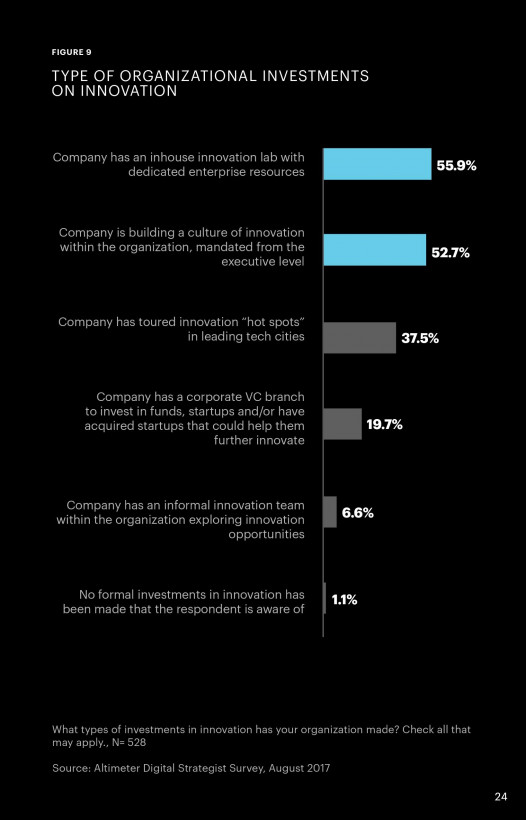
Digital transformation and corporate innovation are two of the biggest trends in business modernization today. For the last several years, I’ve dedicated research to each subject separately to track their progress. In 2017, I conducted a global survey where I merged these research streams into my annual “State of Digital Transformation” series. The goal was to learn how businesses were integrating innovation into digital transformation roadmaps.
Innovation, beyond traditional R&D, is in fact, becoming a corporate mandate within advanced organizations. At the same time, our research also shows that corporate innovation is nascent and an opportunity for organizations to explore new opportunities internally and externally. For example, we learned that only 46% of businesses are investing in innovation strategies to uncover new growth opportunities. Furthermore, just 36.9% are investing in innovation initiatives as a proactive measure to fight disruption. Companies need to be bolder and more aggressive in these disruptive times.
Culture is an Ally or Foe of Innovation
You can’t compete for the future if you don’t invest in the present. One of the challenges in corporate innovation is that executives believe that their organizations are perhaps more innovative than they really are. In a recent research project with CapGemini, “The Digital Culture Gap,” we learned that 75% of senior executives believe their organizations have a culture of innovation, but only 37% of employees feel the same. We also found that only 7% of organizations can test, learn and deploy new ideas rapidly.
Company cultures continue as a top impediment to change; affecting support for digital transformation initiatives on all fronts. This year, culture was tied with lack of budget as the third greatest challenge at 30.5%. Our 2014 research showed corporate culture as the top challenge, with 63% of respondents saying it was “very important” and 34% stating it was “somewhat important” to facilitating progress.
Without an empowered culture focused on agility and growth, digital transformation and innovation are greatly hampered. The good news is that 52.7% of those surveyed are also investing in developing a “culture of innovation” to spark new learning, creativity, and work among the incumbent management and other employees.
Innovation is the Sixth Stage of Digital Transformation
Corporate innovation is vital to uncovering new means and opportunities to better compete. Over the years, I documented the evolution of businesses as digital transformation efforts take shape. In 2016, I introduced the “Six Stages of Digital Transformation” as a maturity model for companies to benchmark their investments and progress against other organizations. The sixth stage of digital transformation is “Innovative and Adaptive.” To get there requires that companies explore the innovation landscape and learn how to be innovative.
The Corporate Innovation Landscape
Innovation programs have to start somewhere.
Many companies start innovation endeavors by gaining exposure to tech companies recognized for their innovation prowess. These companies include, Google, Tesla, Airbnb, Uber, Twitter, among many others. Of the companies we surveyed, 37.5% have sent executives on “innovation tours” or what I call the “Disneyland tour” in Silicon Valley and other technology hot spots around the world. These tours introduce stakeholders and decision-makers to alternative approaches to innovation and transformation. Exposure to entrepreneurs, technology giants, and investors often provides executives new perspectives that reveal new possibilities different from their day-to-day “corporate think.”
As companies gain exposure to innovation ecosystems, often executives are compelled to build innovation labs with dedicated resources (55.9%) to advance new expertise, partnerships, and opportunities.
With digital transformation, companies are not simply adapting to new environments; they also are exploring what is next. Each year, a growing number of businesses are trying to accelerate innovation through formal internal and external programs (39.2%).
More and more companies are also diversifying their investments beyond organizationally led innovation efforts by also establishing corporate venture-capital initiatives. In 2017 for example, 19.7% of companies we surveyed had established a corporate venture capital branch to invest in funds, startup companies, and/or acquire startups to help them further innovate.

ROI: Return on Innovation
Digital transformation faces many challenges as companies attempt to learn and grow. Of those we surveyed, 30.9% stated that digital transformation is viewed as a cost center. As a result, 30.5% and 30.1% cite a lack of budget and resources respectively as hindering business advancement. In our past interviews, we learned that the optics of digital transformation and ultimately innovation are key to progress. Unfortunately, almost one-fourth of respondents claim that politics, egos, fear and other human barriers stand in the way of digital transformation. And, 20% say that there is no sense of urgency within the organization to change.
Making the case for digital transformation and innovation has never been more important. Savvy executives are finding creative ways to unite stakeholders around shorter-term initiatives where innovation is tied to something tangible and measurable.
For example, 40.2% of companies are accelerating innovation by tying progressive and inventive efforts to short-term formal programs (internal and external). Those companies that are excelling prioritize the digital customer experience (CX) and employee experience (EX) to learn, identify gaps and opportunities, and define innovation roadmaps. More so, 42.6% are uncovering ways to link innovation KPIs to business value, i.e. ideas generated, proofs or concept in pipeline, new products created, etc.
CX programs driving innovation include:
- 47.7% – Investing in a more efficient ecommerce and mobile commerce platforms and processes
- 47.5% – Integrating all social, mobile, web, commerce, service e orts and investments to deliver an integrated, frictionless, and omnichannel customer experience
- 42% – Further research into our customer’s digital touchpoints and customer journey
- 36.7% – Utilizing a more holistic and connected CRM system to empower sales teams at every customer touchpoint
- 33.9% – Overhauling customer service to meet expectations of connected consumers
The state of digital transformation continues to take shape. Even though it’s fledgling, organizations in every industry must prioritize innovation as a mandate. Too many executives either downplay the need to innovate or falsely believe they are further along than they really are. This has to change. Decision-makers must recognize the need for change. Right now, 46% of companies are investing in innovation initiatives to more effectively compete in a digital economy. Moreover, 36.9% are proactively investing in innovation programs to fight disruption. This means that despite the adolescence of innovation programs in general, companies are exploring ways to better compete against rivals. Those companies that do not expedite innovation exponentially increase risks of competitive disruption and market obsolesce.
Get the TNW newsletter
Get the most important tech news in your inbox each week.





